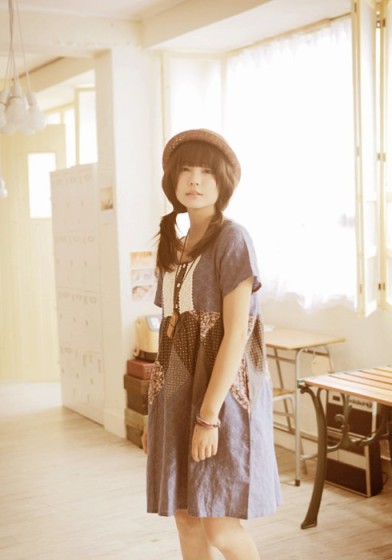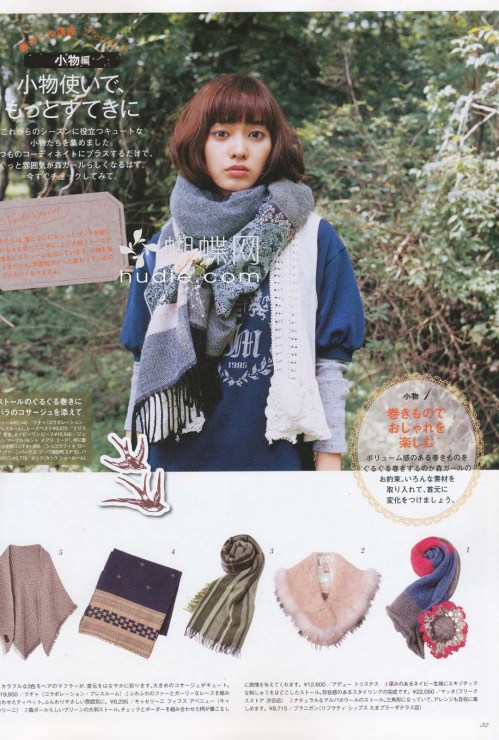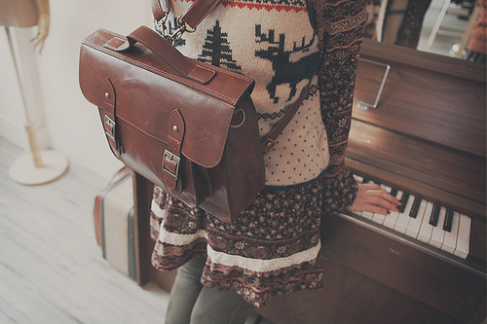Who are the mori girls?
The mori girl blog gives a beautiful introduction to the lifestyle and closet of a mori girl.
In the simplest terms, they are girls who look like they live in a forest.
Most mori girls wear loose-fitting clothing – comfortably, floaty tops and long, wide A-line skirts. They have a predilection to wear a variety of fabrics emphasising a natural look with practical yet rustic grace (akin to stepping out of the fairytale woods). Light cotton blouses and heavier cotton skirts and with lace accents (such as lace sewn on the hem or adorning the collar). Crocheted scarves and socks. Plaid or checked patterns are sometimes used. Straw hats and wooden or woven travelling cases.
The colours are never lurid or startling. A mori girl’s palette (such as her clothing) reflects a natural state of calm; more often than not she prefers subdued hues of brown (both dark and light), faded dark or light pastel/denim blues, green, cream and white. The occasional red colour, whether it be in her hat or a pin, adds fresh perspective to her outfit, like a cluster of new forest fruit amongst the branches.
Walking amongst the grass may not appeal to some mori girls
The lifestyle it advocates is calm, relaxing and idyllic, with a child-like, fairytale-esque innocence. The pace of life a mori girl dreams of and tries to achieve is unapologetically slow-paced. We lose the concept of time in a forest and similarly, in our walks in the neighbourhood. The mori girl lives in quaint corners far removed from the hustle and bustle of a demanding ‘now’ society. Where one hears the birds in the morning. Where, taking a stroll around, one sees streets with rows of small shops – owned by families over generations, perhaps. A bakery, a book-store, a cafe with a news-stand, a florist with her own backyard nursery. A small village church a little worn; someone watering plants in her yard. Such a life encourages us to ‘slow down and breathe and take in our surroundings’.
It tugs at the sleeves of the wondering child inside us, at the dust-caked nostalgia inside our hearts.
A mori girl is…
A list of points/characteristics I have observed in the mori girl community. In a general sense, while scanning the blogs, or community posts of most mori girls, this is what I think the lifestyle reflects.
1. Practical – From hiking boots to Oxfords, brogues and brown boots, the shoes of a mori girl are made for walking miles and miles and handling rough terrain (as the forest floor might often be) while ensuring her feet stay comfy.
There are no rigid rules about it – simply what is best for oneself. Try plain canvas shoes:
2. Versatile – One of my favourite facets about the mori girl is how her wardrobe might change with the seasons or the climate in which she lives and yet enable her to be recognised as a forest dweller. This also contributes a lot to the practicality as seen above. Layering is a favourite of mori girls, to keep them warm during their wanderings in cooler climates. However, what happens when summer arrives, or when a mori girl finds herself in hot and humid surroundings? Mori girls have a knack for improvising while still staying true to their lifestyle.
Warm hats, woollen scarves and boots for cooler weather.
And coordinates for the summer: a lighter feel with less layering and accessories such as a hat or a necklace to add detail. Try on a crocheted vest.
The light cotton fabrics also puts the summer mori girl at liberty to experiment with layering while being under the sun.
3. Calm and relaxed – Mori-themed photoshoots in Spoon or Mori Girl typically depict mori girls with fairly neutral facial expressions: a touch of dreaminess with a slight smile, or a space-out look as if she is lost in thought. Mori girls are quiet when they have to be, and peaceful individuals. They settle like autumn leaves and dust in cafes, trains or quiet nooks, or a favourite spot of hers to sit down. The calming nature of walking. Never too flustered as there is always a secret space, a world of her own inside her mind or in her surroundings, that she finds gladness and beauty in. Inside herself houses a deep joy for simple things.
4. Sensitive to the world around her – Whether it be wading through a particularly intense paragraph or embarking on a lone expedition, she notices the little, elusive details. The hidden shops, the dandelions growing by the roadside. She pays attention to how things (and herself) interact. She breathes in the meaning of things. Some things may be beyond comprehension – her ready admission that one cannot truly know everything more than anything shows her maturing outlook towards her world.
5. Open to experimentation – not every girl is solely a mori girl alone. Before encountering this lifestyle each girl has probably been a part of other styles of clothing and these little influences become a part of us since we know what it means to be dressed in a certain style or rather what living a different lifestyle with a differing outlook on life or personal philosophy means. A mori girl may never forget what it meant to her a year ago when she was a lolita. Or reading Anne of the Green Gables and dreaming about that period in time. Somehow, these preserved memories find their way into her being. Who she is and where she comes from shapes her perception of mori and after all, she is her own mori girl.
Varieties of mori girls:
Swamp Girl – A variation of the mori girl, they embrace the look ‘for all the wrong reasons‘. No pictorial examples at the moment but since they are apparently a subverted type of mori girl I suspect they wear just about the same, though how different/skewed the Swamp (Numa) Girl fashion is I frankly can’t tell. ”Who calls us girls? We’re not girls at all. People often say we look like we’ve crawled out of a swamp or up from the bottom of a well.’
Dark Mori– Also known as ‘dark forest mori’, or ‘black forest mori’; in accordance with their name they take on a more intense, darker twist to the mori girl lifestyle/fashion. If the Mori Girl delights in forest glades and the illuminated/shaded part of the woods, the Dark Mori Girl finds her abode in the neck of the woods where little sunlight reaches, where wolves howl, amongst the gnarled trees with their bare-branched limbs upon which ravens alight. The wolf to the Mori Girl’s deer, the witch in the ancient fairytale.
ShadyOaks wrote probably the first official introduction and concept to Dark Mori. Strega’s Forest has a dark mori checklist which I stumbled upon here.
Natural kei – Moss Garden has written a wonderfully detailed piece about the various facets of the natural kei style. I shall not attempt to add to it because, really, I think it covers almost everything and I’m not too experienced with natural kei myself. See also hierstoria’s article on the ‘difference between mori girl and natural kei’.
Mori lolita – Similar to dolly kei in the use of vintage-looking fabrics and styles with the ‘structured’, formal look of (classic) lolita. The mori lolita also employs antique pieces such as clock-necklaces and key pendants. The mori element in the look comes in the form of breezy scarves and a notable earthy tone to the outfit (browns, brownish reds or greens, even dainty floral patterns) which softens up the usually strict palette of the lolita, giving it a more natural inclination.
In the end of it all there is (fortunately or otherwise) no strict formula to becoming a mori girl. Personally, it is as much a life lived as clothing worn. It is apparent that mori girls are identified mainly by the media and members of the public as just another subculture as documented by their closets. However I would like to think there is something more, and perhaps greater, than being a mori girl on the outside alone. Truly being a mori girl means having a mindset which may be different from the conventional worldview. We imbibe our own notions on the meaning of living life, at a slower pace, pausing intermittently for reflection and simple means of relaxation while feeling for our surroundings. As one mori girl observed, it is ‘really about bringing the magic of the forest into everyday city life’. There are influences about what it entails or what to wear, and some general ideas about living mori that I have tried to outline. Ultimately though there are no exact lines not to cross, nor a list of rules with which to follow. It is this curious notion about the lifestyle which makes mori girls unique and each quite different in their own way.
Credits:
Most pictures are found on pinterest and tumblr (search for ‘mori girl’).
This post would not be possible without ameliecafe and aliceisaninja on the livejournal morigirls community, who contributed their thoughts on mori girl to this article. Thank you!





















